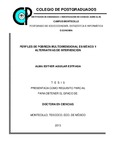Perfiles de pobreza multidimensional en México y alternativas de intervención
Abstract
La pobreza es una realidad que afecta a la mitad de la población en México, a este problema se suma el hecho de que 1 de cada 4 mexicanos presenta inseguridad alimentaria. La magnitud de estas cifras en un país con un nivel de desigualdad como México muestran que este es un problema grave pero también muy heterogéneo, por lo que atenderlo requiere de políticas acordes a carencias particulares que hoy en día es posible identificar a partir de la metodología para medir la pobreza multidimensional. El objetivo de este trabajo fue elaborar perfiles de pobreza a nivel municipal y alternativas de intervención gubernamental, que sirvieran como referencia en la implementación de políticas públicas diferenciadas para atender la pobreza y la inseguridad alimentaria en México. La metodología empleada fue el Análisis Cluster, por medio del cual se obtuvieron 5 tipos de municipios, cuya homogeneidad al interior de cada grupo y heterogeneidad entre sí, reflejan la utilidad de la tipología en el diseño de políticas públicas encaminadas a reducir la pobreza. Los resultados muestran que caracterizar cada tipo de municipio permite visualizar las necesidades prioritarias tanto en el ámbito de bienestar como en el de derechos sociales. Las conclusiones se enmarcan en las alternativas de intervención que se sugieren para cada cluster, distinguiendo las prioridades en cuanto a bienestar y derechos sociales, así como el contexto en el que se considera apropiado un esquema tendiente a la universalización y en qué casos es indispensable focalizar los apoyos. _______________ PROFILES OF MULTIDIMENSIONAL POVERTY IN MÉXICO AND ALTERNATIVES OF INTERVENTION. ABSTRACT: Poverty is a reality that affects half of the population in Mexico, and also, 1 of every 4 Mexicans presents food insecurity. The magnitude of this data in a country with a level of inequality like Mexico means that this is a serious but also very heterogeneous problem. In this sense, the solution requires public policies consistent with particular needs, information that today can be identified based on the methodology for measuring multidimensional poverty in the country. The aim of this work was to develop profiles of municipal poverty and alternatives of governmental intervention, to be able to serve as a reference in the implementation of public policies differentiated to attend to the poverty and food insecurity in Mexico. The used methodology was the Cluster Analysis, which made possible to obtain 5 types of municipalities, the homogeneity to the interior of every group and heterogeneity between them, reflects the usefulness of the typology in the design of public policies directed to reducing poverty. The results show that characterizing every type of municipality allows visualizing the priority needs so much in the area of welfare as in the one of social rights. The conclusions turn around the alternatives of intervention that are suggested for every cluster, identifying priorities as for well-being and social rights, as well as the context in the one that is considered better a scheme tending to the universalization and in what cases it is indispensable the focalization.
Collections
- Tesis MC, MT, MP y DC [263]


